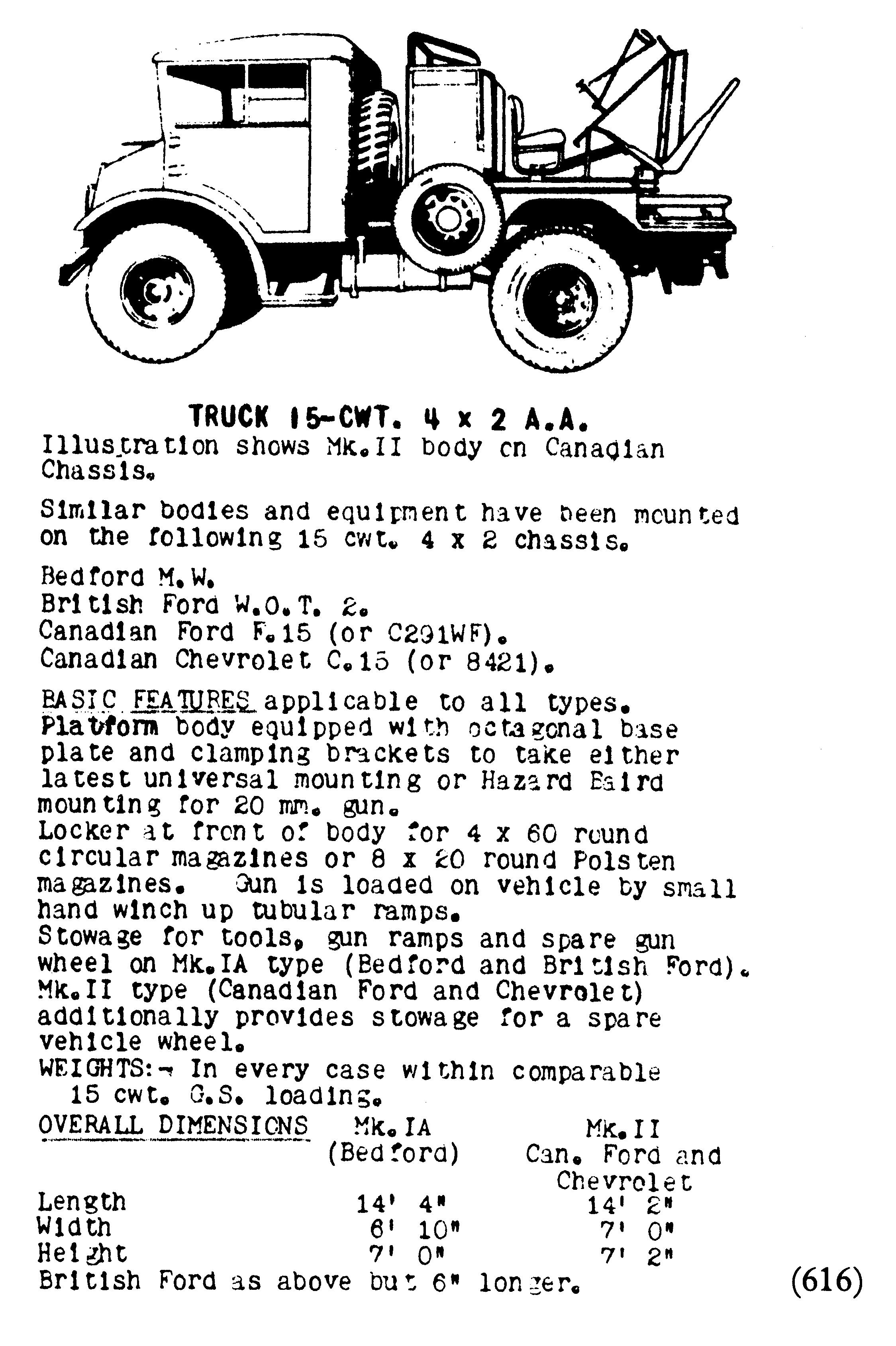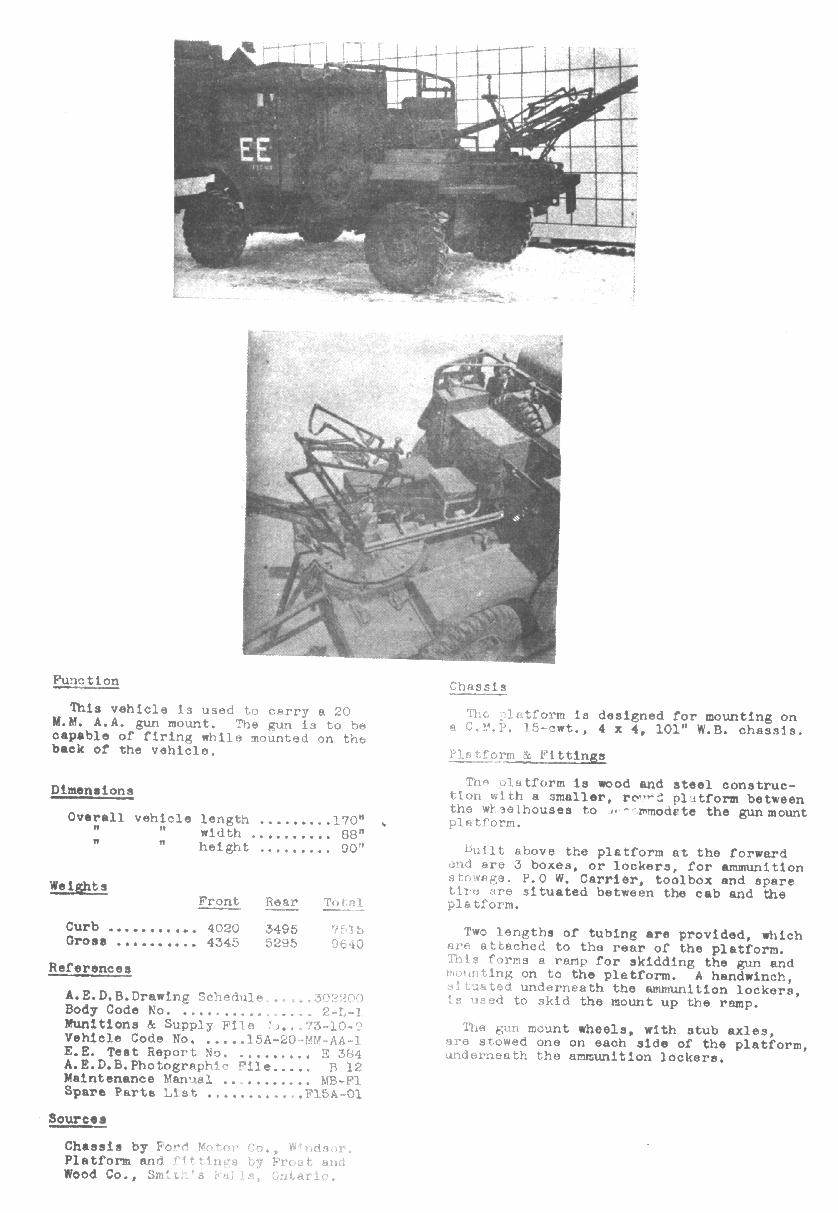- Yes
- No
Introduction:
For today’s vehicle we have a mass produced 20mm polsten weapon system called the Polsten Portee, that saw over 2000 units produced during the second world war to supply light AA regiments of the British armed forces , and other commonwealth units. The versitility of the mounting allowed it to be mounted on astandard truck chassis without serious modification, allowing it to be fired in a stable manner from the truck bed, or if nessessary removed and placed in a entrenched position if required without the need of specilist equitment. The polsten is a simplified oerliken 20mm gun (present on multiple naval vessels and a few AA currently in the british tech tree), requiring less parts to manufacture allowing it to be more viable in the war economy, and as such more appealing to the war office as it was compatible with existing stockpiles of oerlikin ammunition.
Only a fraction of the guns were mounted on Truck chassis, with the majority being used for dug in positions or being towed with trailers, though at least 250 were manufactured in the bedford plant using knockdown kits in preperation for D-day, to reinforce the AA capablities of the beach fronts in anticipation for the expected luftewaffe reprisals. Because of this the vehicles are known to have seen action in the first month or so after the DD landings in the XXX corps of the british army, in several Light Anti Air regiments including the 119th LAA RA, 92 LAA Regiment, RA, and the 15th (Isle of Man) Light Anti-Aircraft Brigade, Royal Artillery.
Vehicle history:
In the preperation for the D-day landings the British army command was incredibly concerned about air attacks on the beachheads after the significant emotional event that was Dunkirk, as well as lessons learned during the dieppe raid. Because of this they wanted as much SPAA on the beach as possible in the first two days of the landing operations, to deter air attacks and protect the vunreable landing ships. This took the form of multiple Light A A regiments being deployed to the theater as part of the XXX corps with a copious amount of armament to protect the british and canadian landing zones from the expected bombing and rocket attacks.
During this period the 119 LAA Regt was organised in the following arragment until august of 1944, this seems to have been the standard arangement with 40mm morris trucks outnumbering the 20mm polsten cars 3 to 1:
- 390 LAA Bty – A, B & C Tps (40mm), X Tp (20mm)
- 391 LAA Bty – D, E & F Tps (40mm), Y Tp (20mm)
- 392 LAA Bty – G, H & I Tps (40mm), Z Tp (20mm)
during the initial disembarkment during the normandy landings the 40mm morris trucks also each towed a trailer mounted 40mm bofors, to further supliment the beachfronts AA after they waded ashore and deployed.
The 20mm trucks where short lived in front line service though, as in the weeks following the landings it became clear the expected luftwaffe threat would not manifest and the 20mm trucks where recalled to the united kingdom for secondary roles. For example for the 15th scottish division was ordered to return their 20mm trucks to stores on the 7th august, with them complying with this order on the 11th of august according to their war diaries.
The reason the CMP trucks where chosen for this job was because the british literally owned over a hundred thousand examples of the class, in various examples aquired through lend-lease, local production. by the end of the war the British armed forces had enough CMP trucks to equip 1 to every 3 members of the british armed forces, and more where produced that the combined truck production of all three major axis powers, which is an obsurd amount when you think about it, as the estimates put a production total in the 800,000 range covering all variants. in summery they were common, numerous and easily avalible, so much so that the entire 8th armoured’s truck contingent during 1943 was composed of these trucks. The british requirement was so great for this vehicle, that the canadian production facilities switched the production from left hand drive for their own examples to right hand drive for british commonwealth units.
Historical Photos and footage:
Image 1, showing 92 LAA Regiment, RA being unloaded on juno beach the day after operation overlord began. The breakdown of the unit can be found on juno beach landing tables, where the vehicles are listed by their chassis, in this case ford 4x2 (page 197 of the pdf). If one looks closely you can see the unit identification decal for the 2nd british army on the back left of the cab on the second vehicle,
Hide contents
Historical footage showing units of the 119th LAA Regiment, then assigned to the 15th scottish, xxx corps, moving through the deserted and derelict town of Caumont courtesty of the IWM:
Video 1 (1:38):
Video 2 (1:18) :
If the footage is paused you can see the scottish lion of the 15th scottish division on the back of the cab of the left wheel rear mudflap of the 40mm morris bofors, and on the rear cab of both 20mm polsten f.15 vehciles, meaning these SPAA belonging to the 119th LAA regiment. The presense of these 20mm polsten cars are again mentioned in the history of the unit in an article published in the queens own gazette for march of 1945, which lists 20mm polsten’s in addition to the units bofors trucks. Home | Looking for Lilith Theatre Company (page 64 (78 of pdf)). The presence of a hatch on the side windows denotes the vehicle as being a f.15 chassis (Image 3), as it was not present on the other CMP models, as the only way they varied was in cab and engine size, as most other facets of the chassis remained universal between models. you might also notice that due to a guy standing up through the roof on the left side this is a right hand drive vehicle, meaning it was one made for sale as part of canadia’s considerable aid to the british.
Hide contents
Vehicle specification:
Hide contents
Hide contents
A 60 round drum magazine its loaded onto the top of the gun, and is taken from a ammunition supply (600 rounds) stored behind the drivers cab. The trigger is located in front of the right handgrip. After shooting, the empty cases are ejected under the weapon into a mesh-reinforced bag intended to protect the gunner as well as allow the brass to be easily collected. The vehicle has a crew of three: the gunner; the observer/commander, identifying targets for the gunner; and the loader, who supplied the weapon with ammunition. The vehicle was intended to be used as an anti-aircraft weapon, but if nessassary could be used against infantry and soft targets. A light wheeled carriage was used, this was designed to allow 360’ traverse and is capable of high-speed travel, though due to the trucks cabin it is not able to depress over the forward arc, additionally no gun shield was fitted. The system was most often mounted on CMP 15cwt trucks for easy mobility.
Polsten Characteristics:
Calibre: 20 mm
Weight: 480 kg without ammunition
Traverse: -15° with + 90°
Practical maximum range: 2000 meters
Muzzle Velocity: 820 m/s
Rate of Fire: 450 rounds/minute
Sources:
- British Data Book, 1944, page 616
- AEDB Design Record for Canadian Military Pattern 20mm AA 15 Cwt Cab 13 truck under test
- https://forum.shrapnelgames.com/showthread.php?t=45662
- 119th LAA RA - Formation AOS and TAC signs | WW2Talk
- F15 4x2 A/A platform - MLU FORUM
- War diarys of the desert rats: War Diaries of 15th Isle of Man Light Anti-Aircraft Regiment Royal Artillery 1939 to 1945
- War diarys of the 119th regiment 1944 jan-december 119 Regt. | The National Archives
- 15th scottish division war diaries https://www.15thscottishdivisionwardiaries.co.uk/copy-of-284-coy-1
- THE BRITISH 2ND ARMY ATTACKS SOUTHWARD FROM CAUMONT [Allocated Title] | Imperial War Museums
- 30TH CORPS IN ACTION SOUTH OF CAUMONT [Allocated Title] | Imperial War Museums
- Postan, M. M.; Hay, D.; Scott, J. D. (1964). Hancock, K. (ed.). Design and Development of Weapons: Studies in Government and Industrial Organisation. History of the Second World War, United Kingdom Civil Series. London: HMSO & Longmans, Green & Co. ISBN 978-0-11630-089-8.
- juno beach landing time tables http://www.6juin1944.com/assaut/juno/tables.pdf
- page 64 (78 of pdf) outlining the composition of the 119th LAA regiment at the time of its return to britian: Home | Looking for Lilith Theatre Company









